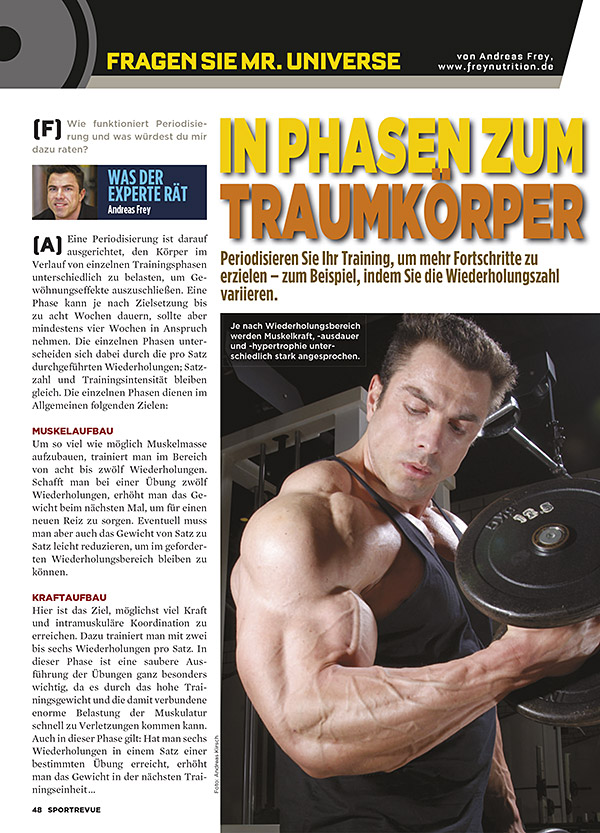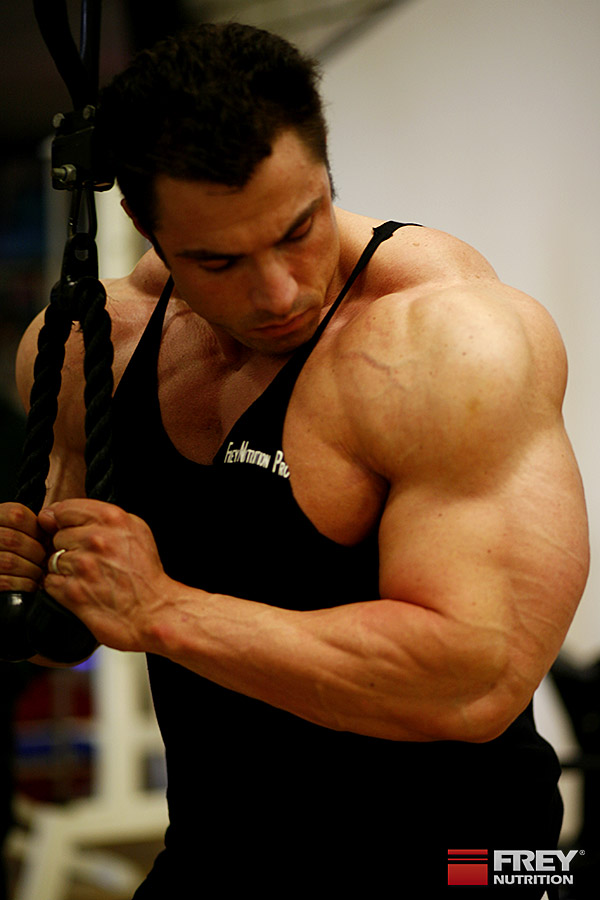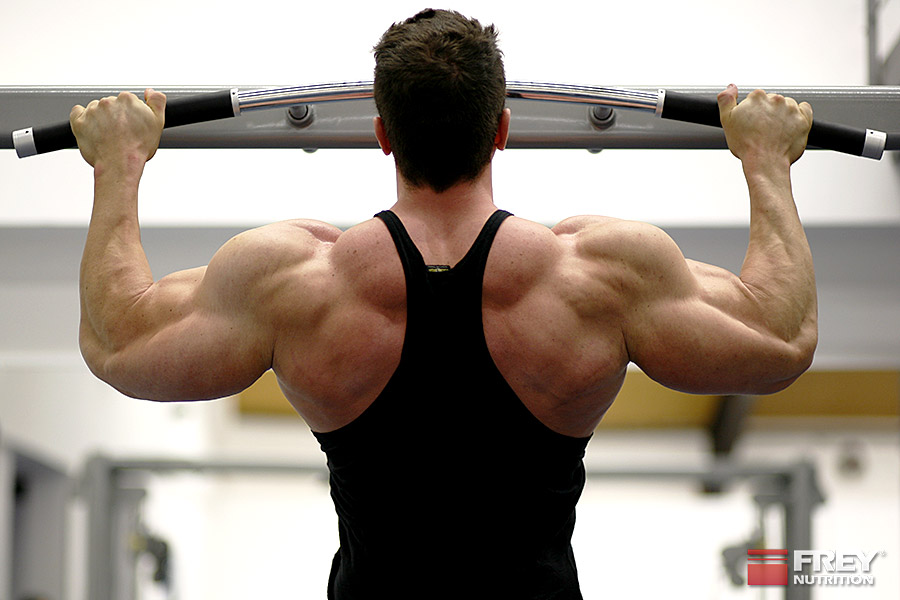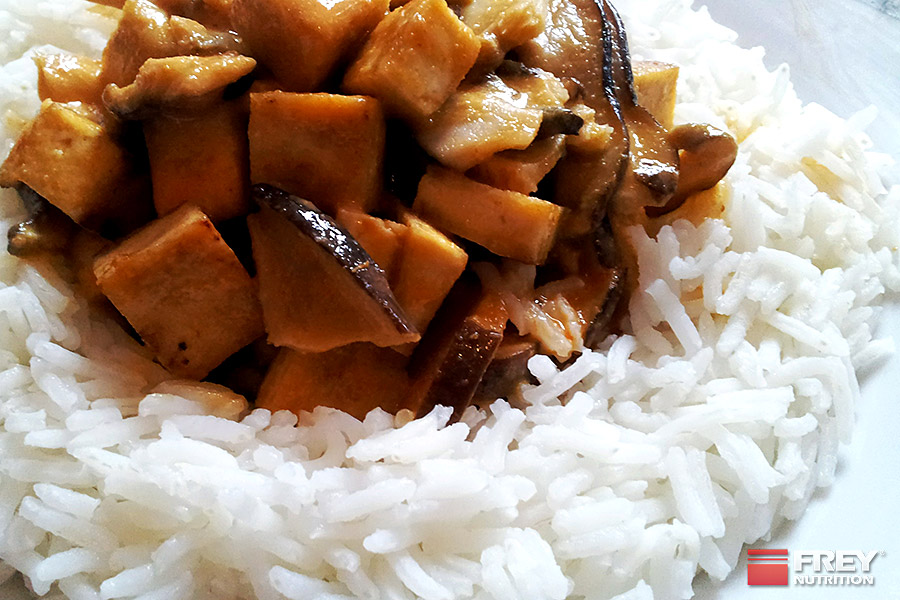55. PHASES TO THE DREAM BODY
COLUMN 55 |
IN PHASES TO THE DREAM BODY

ANSWER
!

MUSCLE BUILDING
To build as much muscle mass as possible, train in the range of eight to twelve repetitions. If you manage twelve repetitions of an exercise, increase the weight the next time to provide a new stimulus. However, you may also have to reduce the weight slightly from set to set in order to stay within the required repetition range.STRENGTH BUILDING
The aim here is to achieve as much strength and intramuscular coordination as possible. To do this, you train with two to six repetitions per set. In this phase, it is particularly important to perform the exercises correctly, as the high training weight and the associated enormous strain on the muscles can quickly lead to injuries. The following also applies in this phase: once you have achieved six repetitions in a set of a certain exercise, you increase the weight in the next training session...MUSCLE ENDURANCE
In this phase, the aim is to build up maximum capillarization of the muscle cells and to increase endurance - and thus to stimulate the red, slow-twitch muscle fibers. To do this, you train with around 20 repetitions. The tempo of the movements can be a little faster than in the other phases, but the execution should always be clean and controlled. If you reach 20 repetitions in one set, you increase the weight of the exercise in the next training session to further challenge the muscle. Depending on the repetition range, muscle strength, endurance and hypertrophy are addressed to varying degrees.
CONCLUSION
Periodization is generally a good way to avoid getting used to the training load. I myself trained according to this principle for a long time. But it also has its limits: even if you always achieve good results within a certain phase, these can be limited again by switching to the next phase, as the muscles are stressed differently by the different repetition range. On the other hand, in this new phase you basically start from scratch and have to "train up" again. In the end, the results are good as expected, but can be reduced again by switching to the next phase. Even if you achieve good results within a certain phase, these can be limited again by moving on to the next phase.
This is a recurring cycle that is inherent in the system. In order to achieve consistent success, however, I looked for a variation of this strategy. I came across the "holistic training system" with which I can combine the three phases mentioned in one training session - the perfect solution for me! I currently divide each workout into three corresponding areas: the first is about building muscle, the second is about building strength and the third is about muscle endurance.
I have been training with this system for over ten years now with great success. Although it is very effective, I believe that bodybuilding beginners should first train according to the traditional principle - i.e. building muscle with eight to twelve repetitions per set - and only then gain experience with the periodization method. And only then does it make sense to experiment with the holistic training principle. It is ideal for preventing the muscles from getting used to it, as different systems are always used. This is particularly beneficial for advanced athletes.WHITE RICE IN THE DIET?
?
Does white rice make sense in a diet? Because it has a relatively high glycemic index. I eat rice with meals during the day and vegetables as a side dish in the evening. I am 1.70 meters tall and weigh 90 kilos.
ANSWER
!
In general, rice is a very good and high-quality source of carbohydrates. It is an essential part of any serious bodybuilder's diet and build-up phase in order to meet their carbohydrate needs.
But there are differences - especially when it comes to the glycemic index (GI) you mentioned: conventional white rice is only second choice for me in this regard. Firstly, it has a relatively high GI of around 70, and secondly, it is relatively low in nutrients due to the extensive processing.
If you want to use rice as a carbohydrate source, basmati rice is an excellent choice.
Wholegrain or brown rice would be better here, for example. But it doesn't taste good to everyone and is only suitable to a limited extent for the build-up phase. It is very filling and therefore makes it difficult to get regular and extensive nutrient intake, which is so important for the build-up phase (for example due to a feeling of fullness and loss of appetite).
An excellent compromise is basmati rice. It has a lower GI of around 50. Its special aroma also makes it taste good and it is absolutely suitable for both the building phase and the diet phase. If you want to use rice as a basic source of carbohydrates, I highly recommend basmati rice!
SEND US YOUR QUESTION!
Do you have any questions about bodybuilding, nutrition, training or supplements? Then send us your question by email to: INFO@FREYNUTRITION.DEThis will then be answered personally by Andreas Frey in the form of a column and published here!












